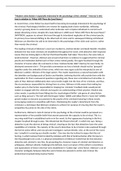“Modern crime fiction is especially interested in the psychology of the criminal.” How far is this
true in relation to ‘When Will There Be Good News?’
In recent times, crime fiction has leant itself to becoming increasingly interested in the psychology of
the criminal. Psychological thrillers are renown for topping book charts worldwide, reflecting
society’s growing desire to understand what motivates such complex individuals to commit such
deeply disturbing crimes. Despite this, Kate Atkinson’s 2008 novel ‘When Will There Be Good News?’
(WWTBGN), appears to subvert this trend through its intentional neglection of the criminal psyche,
its primary focus instead shifting to the aftermath of crime and its subsequent lifelong victimhood.
Atkinson can therefore be said to be interested in the psychology of the victim and survivor, rather
than merely the criminal.
The leading criminals of Atkinson’s novel are murderers, Andrew Decker and David Needler. Parallels
between the two male criminals are established throughout the novel, with detective chief inspector
Louise Monroe shining light on the fact that David Needler had taken ‘three lives, the same tally as
Andrew Decker’. However, Atkinson also ensures that there is evidence to suggest that the criminal
psyche and motivation behind each of their crimes varied greatly, this again focalised through the
character of Louise when she comments on how ‘Andrew Decker didn’t destroy his own family, he
destroyed someone else’s’. This provides commentary on how criminals should not be “grouped”
together under the umbrella of their crime, which one may argue could be interpreted as one of
Atkinson’s subtler criticisms of the legal system. The reader experiences a natural fascination with
the identities and backgrounds of Decker and Needler, believing that this will provide them with the
explanation for their unanswered questions regarding why these men committed such atrocities. In
spite of that, Atkinson deliberately does not provide insight into the lives of her criminals, and thus,
the circumstances responsible for driving them to crime. Atkinson is fully aware that making her
readers privy to the factors responsible for shaping her criminals’ troubled minds would permit
readers to engage with the criminals and acquire an understanding of their psyches. Modern day
crime novels, in particular those fitting into the ‘psychological thriller’ sub-genre of crime fiction,
such as Stieg Larsson’s ‘The Girl with the Dragon Tattoo’ (2005) and Gillian Flynn’s ‘Gone Girl’ (2008),
permit readers to become accustomed to the psyche of the criminals featuring in these novels,
encouraging readers to empathise with them. Maintaining the reader’s detachment from the
criminals is a technique that Atkinson employs to achieve her purpose of ensuring that the reader’s
sympathies lie purely on the side of the victim.
Furthermore, Atkinson’s lack of interest in the psychology of the criminal could be perceived as a
representation of her possible belief that anyone possesses the capacity to be criminal. This is a
recurring motif that is established early on in the novel, its first appearance featuring in the first
chapter focalised through Louise, ‘She Would Get the Flowers Herself’, in which she says ‘being a
detective is just the obverse of being criminal’, drawing on the fact that detectives have the same
capabilities of criminals. The capacity of the novel’s detectives to be criminal is also explored through
the former police officer and now private investigator, Jackson Brodie, who, at the end of the novel,
was ‘complicit in covering up a double murder’. One may also be inclined to argue that the red
herring, in which Jackson finds his identity mistaken with that of Andrew Decker after his injury in
the Musselburgh train crash, is a physical embodiment of Atkinson’s belief that the line between
detective and criminal is very fine. By presenting the character tropes of criminal and detective as
ambiguous, Atkinson directly challenges the defined, clean-cut nature of the uniform conventions
and expectations of these roles that were established in ‘Golden Age’ crime fiction. Atkinson’s use of
character ambiguity between detective and criminal also extends to victim and criminal, the
predominant example being Joanna Hunter.




